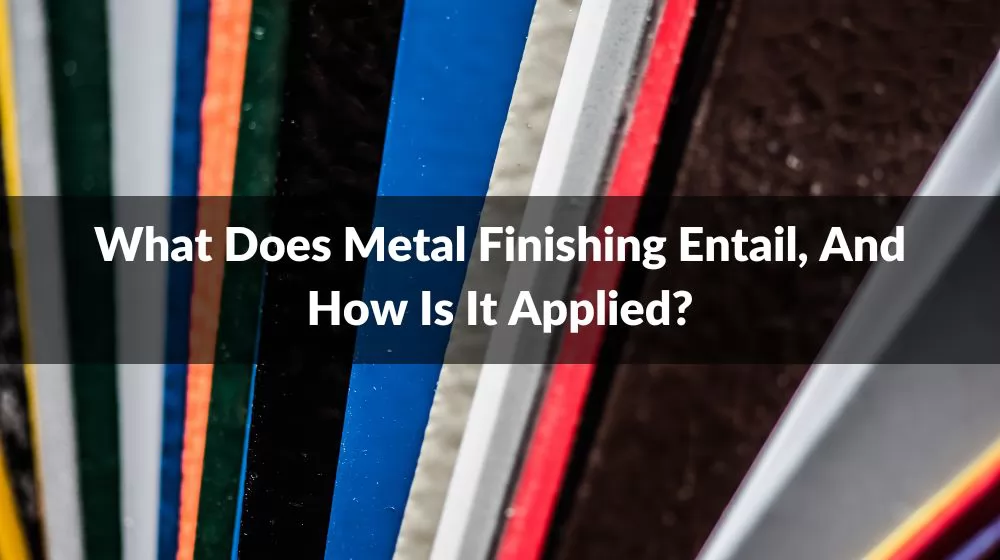
.png)

.png)
.png)


-
.png) 0086-757-85407388
0086-757-85407388 -

-
 terrychen@wintoly.com
terrychen@wintoly.com


.png)

.png)
.png)


.png)




Table of contents:
Metal finishing is a transformative process that goes beyond the mere surface of metal objects, aiming to enhance their functionality, aesthetics, and durability. This intricate realm of engineering involves a variety of techniques and applications, each tailored to meet specific requirements across diverse industries. From protecting against corrosion to elevating visual appeal, metal finishing is a critical step in the manufacturing journey of countless products. In this exploration, we delve into what metal finishing entails and how this meticulous craft is skillfully applied to shape the characteristics of various metal components.
Metal finishing refers to the process of altering the surface of a metal object to enhance its appearance, durability, and corrosion resistance. This transformative procedure involves various techniques and methods, all aimed at improving the overall quality and performance of the metal. Metal finishing is a crucial step in the manufacturing and engineering industries, as it not only provides aesthetic appeal but also contributes to the longevity and functionality of the metal components.
The importance of metal finishing in various industries cannot be overstated, as it plays a pivotal role in enhancing the functionality, durability, and overall quality of metal products. Here are key aspects that highlight the significance of metal finishing:
Corrosion Protection:
Metal surfaces are susceptible to corrosion when exposed to environmental factors such as moisture, chemicals, and pollutants. Metal finishing, through processes like galvanization or protective coatings, creates a barrier that shields the metal from corrosion. This is particularly crucial for applications in outdoor settings or industries where exposure to harsh conditions is common.
Aesthetic Appeal:
Beyond functionality, metal finishing is essential for improving the visual appearance of metal products. Whether it's a decorative coating, polishing, or a specialized finish, these processes contribute to the overall aesthetics of the metal. This is vital in industries where the visual appeal of the final product is a key consideration, such as consumer goods or architectural applications.
Enhanced Durability and Wear Resistance:
Metal finishing techniques, including heat treatment and surface hardening, are employed to increase the durability and wear resistance of metal components. This is particularly valuable in applications where metals are subjected to constant friction, abrasion, or impact. The enhanced durability ensures a longer lifespan for the metal products.
Functional Optimization:
Metal finishing goes beyond surface aesthetics; it is instrumental in optimizing the functionality of metal components. Various treatments and coatings are applied to improve the mechanical and physical properties of the metal, making it better suited for specific applications. This includes improving hardness, tensile strength, and other mechanical characteristics.
Compliance with Industry Standards:
In many industries, there are specific standards and regulations regarding the quality and performance of metal products. Metal finishing processes are often employed to meet these standards and ensure that the finished products adhere to regulatory requirements. This is particularly crucial in sectors such as aerospace, automotive, and medical devices.
Cost Savings:
Proper metal finishing can contribute to cost savings in the long run by extending the life of metal components. The protection against corrosion and wear reduces the need for frequent replacements, leading to increased cost-effectiveness for industries that rely on durable and long-lasting metal products.

All types of metal finishing offer benefits that enhance your metal products in industrial and aesthetic ways. While the advantages depend on the particular process you use, general benefits of finishing include:
Strengthen the substrate: An additional exterior layer increases wear resistance and help protect your products to ensure they last longer.
Reduce effects of friction and corrosion: A metal coating limits the impact of corrosion and friction on the substrate.
Create electrical conductivity: Certain finishes will make your product’s surface electrically conductive.
Enhance chemical resistance: An extra coat increases the substrate’s ability to withstand exposure to certain chemicals.
Upgrade appearance: Many finishes or coatings provide a brushed or polished look.
Improve paint cohesion: The finish can serve as a primer coat that allows you to apply paint to your products.
Clean the surface: Basic finishes clean the substrate and can remove surface defects.
While people sometimes use terms like “plating” and “finishing” interchangeably, there are numerous metal finishing solutions available that work in different ways and offer varying results. Check out the most common types of metal finishing solutions so you can decide which is right for your operations.
ELECTROPLATING
One of the most popular finishing solutions, electroplating is also known as electrodeposition. This method consists of depositing metal or a metal alloy onto a substrate’s surface. An electric current passes through a liquid bath made of the metal and substrate’s dissolved ions, coating the surface. While most commonly used for metal materials, electroplating can be used for some plastic and non-metallic surfaces as well.
This method requires specific and professional expertise. Proper electroplating will improve the durability, corrosion resistance and appearance of your products.
BRUSHING AND CLEANING
Rather than adding a layer, brushing and cleaning address the substrate’s existing surface. Brushing and cleaning machines clean the product’s surface and get rid of small imperfections in the metal. A belt or wire brush creates a uniform appearance and eliminates excess material or debris. An acid or chemical bath typically completes the cleaning process, removing any leftover residue and leaving you with an aesthetically pleasing product.
POLISHING
Polishing can smooth your metal products and provide a glossy finish. There are two common types of polishing — electropolishing and buff polishing.
Electropolishing, as the name suggests, uses an electrochemical reaction to create a clean, polished surface. This process is the opposite of electroplating — polishing removes ions from the substrate rather than adding another layer.
Buff polishing is a more traditional method consisting of a belt machine that buffs the surface of your metal product. Manufacturers often implement buff polishing to give materials a shiny, decorative appearance.
GRINDING
Similar to polishing, grinders smooth materials with abrasive pressure. Common grinding machines include surface grinders, Blanchard grinders, centerless grinders and even types of hand grinders, each of which utilizes a different technique to provide the even finish you’re looking for. Grinding is often a final step in the finishing process, removing debris from the substrate surface and creating a better appearance.
VIBRATORY FINISHING
Vibratory finishing machines use the friction caused by vibrations to clean, polish or deburr metal materials and parts. This wet or dry process, depending on the application, will offer cleaner, more effective and lasting parts for your products. Vibratory finishing can handle a large volume of parts at one time, making it a cost-effective finishing solution. Learn more about mass vibratory finishing equipment from Finishing Systems.
BLASTING
Abrasive blasting is an effective way to clean, deburr, scale, polish or otherwise improve your metal parts and products. Blasting typically relies on either pressurized air or a motor-driven wheel to propel a stream of materials against an object. The stream excises unwanted materials and leaves your product with the desired finish. Finishing Systems offers blast equipment solutions for your operations.
HEAT TREATING
Heat treatments are an essential step in many metal manufacturing processes. You can use heat treating to create desired characteristics in metal products after they’ve reached their final shape. Hardening the material with heat increases its strength and wear resistance, creating a more durable product. Heat treatments sometimes involve cooling materials to achieve the desired hardness or softness.
Heat treating also removes residual stresses and other defects from metal materials.
COATING
Depending on your product, you may have coating options beyond electroplating. Other types of coatings for metal finishes include paint layers and powder coatings.
Powder coating uses a polymer powder to create a glossy, matte or textured surface on a substrate. This decorative finish has increased durability compared to paint, can hide surface imperfections and offers low-cost protection against corrosion and wear. These dry powder coatings are often thicker than liquid layers, and you can apply them to non-metallic materials like plastics as well.
HOT BLACKENING
Hot blackening is a method typically used when you want a black, matte finish on your metal parts or components. After getting a layer of black oxide, the product goes through tanks of various coolants and cleaners. Hot blackening offers a sleek appearance and improved abrasion resistance to ensure your materials last. You’ll often find this method used in automotive, firearm, military and tool applications.

Metal finishing is a testament to the union of science and craftsmanship in manufacturing. From the precision required for aerospace components to the elegance sought after in consumer products, the applications are as diverse as the finishes themselves. If your company needs surface treatment solutions, please contact Wintoly! Provide you with high-quality products and services!

 terrychen@wintoly.com
terrychen@wintoly.com
.png) 0086-757-85407388
0086-757-85407388
 6 Chaoyang Rd., National Demonstration Eco-industrialzone, Nanhai, Foshan,Guangdong,China
6 Chaoyang Rd., National Demonstration Eco-industrialzone, Nanhai, Foshan,Guangdong,China

.png)
